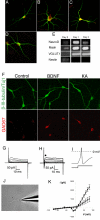Enriched monolayer precursor cell cultures from micro-dissected adult mouse dentate gyrus yield functional granule cell-like neurons
- PMID: 17460755
- PMCID: PMC1849968
- DOI: 10.1371/journal.pone.0000388
Enriched monolayer precursor cell cultures from micro-dissected adult mouse dentate gyrus yield functional granule cell-like neurons
Abstract
Background: Stem cell cultures are key tools of basic and applied research in Regenerative Medicine. In the adult mammalian brain, lifelong neurogenesis originating from local precursor cells occurs in the neurogenic regions of the hippocampal dentate gyrus. Despite widespread interest in adult hippocampal neurogenesis and the use of mouse models to study it, no protocol existed for adult murine long-term precursor cell cultures with hippocampus-specific differentiation potential.
Methodology/principal findings: We describe a new strategy to obtain serum-free monolayer cultures of neural precursor cells from microdissected dentate gyrus of adult mice. Neurons generated from these adherent hippocampal precursor cell cultures expressed the characteristic markers like transcription factor Prox1 and showed the TTX-sensitive sodium currents of mature granule cells in vivo. Similar to granule cells in vivo, treatment with kainic acid or brain derived neurotrophic factor (BDNF) elicited the expression of GABAergic markers, further supporting the correspondence between the in vitro and in vivo phenotype. When plated as single cells (in individual wells) or at lowest density for two to three consecutive generations, a subset of the cells showed self-renewal and gave rise to cells with properties of neurons, astrocytes and oligodendrocytes. The precursor cell fate was sensitive to culture conditions with their phenotype highly influenced by factors within the media (sonic hedgehog, BMP, LIF) and externally applied growth factors (EGF, FGF2, BDNF, and NT3).
Conclusions/significance: We report the conditions required to generate adult murine dentate gyrus precursor cell cultures and to analyze functional properties of precursor cells and their differentiated granule cell-like progeny in vitro.
Conflict of interest statement
Figures





References
-
- Gage FH. Mammalian neural stem cells. Science. 2000;287(5457):1433–1438. - PubMed
-
- Kempermann G, Jessberger S, Steiner B, Kronenberg G. Milestones of neuronal development in the adult hippocampus. Trends Neurosci. 2004;27(8):447–452. - PubMed
-
- Palmer TD, Takahashi J, Gage FH. The adult rat hippocampus contains primordial neural stem cells. Mol Cell Neurosci. 1997;8(6):389–404. - PubMed
Publication types
MeSH terms
LinkOut - more resources
Full Text Sources
Molecular Biology Databases

